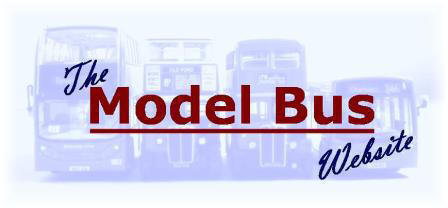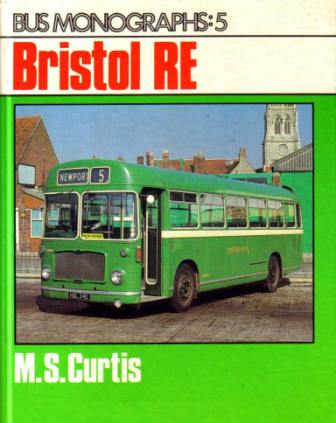
BRISTOL RE - BOOK REVIEW - ANDREW GLASSE
|
|
BRISTOL RE - BOOK REVIEW - ANDREW GLASSE |
 Bus
Monographs: 5 - Bristol RE
Bus
Monographs: 5 - Bristol RE
Martin S. Curtis
ISBN
0-7110-1683-6 - 175mm x 240mm - 96 pages - Hardback
Illustrated in monochrome
The Bristol RE, The - A Family Profile
Simon Butler
ISBN
1-870484-00-2 - 225mm x 210mm - 128 pages - Hardback
Illustrated in monochrome
 I was
recently glad to be able to use Amazon’s efficient ordering system in obtaining
two useful books on the Bristol RE chassis, back in model bus collectors’ focus
with the introduction of the RELH coach in model form from EFE at the end of
last year. Simon Butler is the author of The Bristol RE A Family Profile,
published by Trevellan Books in 1987, while M.S. Curtis is responsible for
Bristol RE, which is number 5 in the Bus Monograph series from Martin
Curtis and Ian Allen and which appeared in 1986.
I was
recently glad to be able to use Amazon’s efficient ordering system in obtaining
two useful books on the Bristol RE chassis, back in model bus collectors’ focus
with the introduction of the RELH coach in model form from EFE at the end of
last year. Simon Butler is the author of The Bristol RE A Family Profile,
published by Trevellan Books in 1987, while M.S. Curtis is responsible for
Bristol RE, which is number 5 in the Bus Monograph series from Martin
Curtis and Ian Allen and which appeared in 1986.
Two relatively dated books, then, but both produced after the RE chassis had been there, and done it, in a remarkably successful fashion. It is interesting to compare these two books with each other, and with Duncan Roberts’ Bristol RE, 40 years of service, which came from NBC Books in 2002. This work, far more comprehensive than the others, is regarded as a bible as regards the RE, rightly so in my view. Apart from decrying the many printing errors in my edition, I do not intend to review that book here, just to use it as a backdrop for this short review of the two others.
Both books are relatively small, the monograph being of ninety-six pages while the Butler being of one hundred and twenty eight. Both books are richly illustrated with black and white photographs, and although the RELH coach is not well represented, there are plenty of interesting pictures of vehicles I only vaguely remember, or have never even heard of; the New Zealand and Ulster stories being well covered in the Butler book. A picture of a Pennine-bodied RELL6G ex-Reading seen on Malta was an eye-opener in the monograph and the 1972 photograph of an RESL with an East Lancs body was another one of a bus I had never seen before. By the way, not many of these “foreign-bodied“ REs look anything as good as the Lowestoft products most commonly wedded to the RE. One exception must of course be the Alexander “M”, but then I am biased! My favourite photographs are in the monograph, on page 52, showing two “M”s in original Western and Eastern Scottish livery at Victoria. The rear-view of the Eastern vehicle (XA 349) shows it with a large air-intake fin at the back end of the roof. I had forgotten about this detail, which I don’t think lasted long. It is pictures like this that make this book worth the money.
Both books tell the story of the chassis, from its three experimental prototypes, through development and improvement and on into general service with the Tilling Group and finally on general release, so to speak. This story is well-known to enthusiasts and need not be retold here. Suffice it to say that for the uninitiated, both books tell it in a comprehensive and easily understood way. There seems to be a certain amount of perhaps understandably negative slant against Leyland , particularly in Simon Butler’s narrative. The painful history of what happened to the Leyland concern afterwards makes this an ironic read. Coupled to this is the story of ECW’s demise. Why on earth did they not have a new body on offer for the REMH in 1970? This let in Plaxton, who became the preferred choice for the NBC coaching department thereafter, and this surrender by ECW and the Leyland politicking which contributed to finishing off the production of the Bristol chassis are well detailed in both books.
So which book do I prefer? My choice goes with the Simon Butler version. The main reason for this is the inclusion of a large amount of technical information and statistics which give the book a more scientific basis. Duncan Roberts’ book is also well-stocked in this respect, but a good example in Butler’s book are tables showing the distribution of the newly delivered Mark 2 RELH amongst the NBC companies. This is an interesting summary where both fleet numbers and registrations are included. Other statistics I read for the first time were in tables entitled “Vehicles delivered to Citybus” and “…Ulsterbus”, which detail Alexander RELLs, (nearly all Gardners) which went to Belfast between 1976 and 1884. An accompanying commentary on the way many of these buses met a dramatic, often firey fate in the troubles makes absorbing reading. The list of second-hand REs which were sold from the mainland to Ulster is also part of this picture.
The most interesting information which I personally look for in a book like these is the description of how the vehicles performed on the road. Simon Butler clearly understands this need of mine, because his book includes a long chapter devoted to just this sort of thing. “On the Road” is a look at how the early vehicles were reviewed by heavyweights (in name let me hasten to add) F. K. Moses and A. Alan Townsin. Articles these gentlemen wrote after riding and driving an Eastern National RELHG are reproduced and make a fascinating browse, refreshing fond memories I myself have of these particular coaches. A test run between Bristol and Victoria is also described. This trip can also be read about in Roberts’ RE book, but Simon Butler goes into greater depth. Acceleration and braking tests are tabled, and criticism of details is also described in a very objective sequence. I must be allowed to quote the following, however, just to get this discussion of my favourite coach back onto a subjective level:
From a passenger’s point of view, “the ride was impeccable while the level of noise was remarkably low”. Thank you, I feel better now! The monograph, to be fair, also ends with an “On the Road” chapter. This is written in what appears to be an afterthought, and even though one or two of the same sources are used as in Simon Butler’s excellent account, it is short and lacking in the feel that these buses and coaches gave.
Both these books are useful and well worth the relatively low outlay. I presume, sitting here in Norway, that they must be bought second-hand or on Amazon. I feel they compliment each other, and with the help of the excellent illustrations, they are both well worth buying.
AG